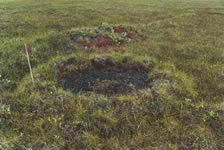
Preliminary Results
There appears to be an inverse relationship between frost boil size/density and the coastal climate gradient, related to changes in vegetation type and distribution along the gradient. Parent material appears to strongly affect frost-boil distribution, with areas of peaty, sandy or gravelly soils having relatively few frost boils compared to silty areas.
Active layer thickness is strongly related to boil location and probably controlled by heat flux differences between barren and well-vegetated areas between boils. Heat flux measurements would lend futher insight to the controls on active layer thickness.
Frost boils were probably once more common in areas of acidic tundra, but as these areas became well-vegetated, the boils became smaller and less active. Evidence of ancient boils is still present beneath the organic layers. Radiocarbon dating of the base of the organic layers would provide insight to the timing of soil stabilization in these acidic areas.
Plant cover strongly affects frost boil activity. The development of deep moss layers, particulary Sphagnum moss, strongly inhibits frost-boil formation.
The soils within boils appear to heave due to ice lenses which probably form in nearly the same position each year and create the strong platey structure of the soils.
Interferometry using time sequences of SAR images may offer a means to identify areas with abundant frost boils due to the relatively large amount of winter-time heave compared to areas without frost boils.
Snow cover appears to play a major role in frost-boil activity, with intermediate depths of snow providing optimum conditions for activity.
It appears that frost-boil formation and activity is a much more complex issue than originally hypothesized. The interactions between ice lens formation, soil cycling, vegetation community development and activity, and snow cover create a complex web of feedbacks that reqiure more anaylsis at the microscale. Further investigation of the biogeochemical cycling within frost boils may play an important role in improving our understanding of these complex relationships.
View preliminary results.
For complete results please see the Data and Field Reports.
